Executive Summary
Abu Dhabi National Oil Company has registered impressive performance in the recent past that has led to its expansion to new markets around the global market. However, the issue of safety at its distribution service stations remains a concern that needs to be addressed properly. Some of the risk factors such as assembly, connection, installation, maintenance, procedures, and work practices have been identified as some of the major causes of accidents within distribution service stations.
Other factors include malfunction, operations failures, misuse of equipment, and carelessness among the attendants or third parties within the stations. Terrorism has also been identified as an issue that may need to be addressed. Managing this threat should be given priority because their impact on the organization may be devastating. The management, employees, the government, and other oil companies must work together as a single system in addressing these concerns. It is only after finding a lasting solution to these threats that the management of ADNOC can consider the firm’s aggressive expansion sustainable.
Introduction
Abu Dhabi National Oil Company (ADNOC) is the largest oil company in the United Arab Emirates. The company has its headquarters in Abu Dhabi. According to Bahgat (2013, p. 53), ADNOC has experienced massive growth over the past decade, and currently, it is ranked one of the top oil companies in the global market. This growth is expected to continue given the effort that the company is putting to expand its operations. This state-owned corporation has managed to withstand economic downturns such as the 2008-2009 economic recessions that hit its major markets in Europe and American continents.
The recent drop in the oil prices that was witnessed in the global market has not affected its growth. This is a clear sign that this company has a bright future in this sensitive industry. However, this impressive growth comes with risks and responsibilities that the management of this firm has to address. The larger the company grows, the bigger these risks and responsibilities become. One of the issues that the management of ADNOC will have to pay close attention to is the safety of distribution service stations.
According to Hults, Thurber, and Vimor (2011, p. 84), there are several hazards and risks associated with petrol stations that an oil company cannot ignore. Risks such as fire explosions, contaminations, environmental damage in case of leaks, among other concerns are real issues that should be taken into consideration by the relevant authorities within the firm to avoid accidents at the service stations. Managing these risks should be a priority as the firm expands its global market coverage. In this study, the researcher will look at the hazards and risks associated with petrol stations and how the management of ADNOC can manage these risks to avoid potential threats at all its service stations in the global market.
Literature review
According to Plunkett (2008, p. 74), safety assessment at the petrol stations is one of the issues that academic scholars have ignored for a very long time. Most of the available literature on safety issues, accidents, and incidents at petrol service stations is in newspapers or journal articles that were specifically commissioned by a company. Safety of petrol stations is one of the critical issues that should not be ignored because the consequences are always dire. Petrol stations are very important because the automotive we use wholly relies on fuel.
However, Kretschmer (2011, p. 11) observes that it is unfortunate that not many people know about the safety measures that should be taken when one is within the station. According to Shah (2009, p. 90), most of the accidents that occur at petrol stations are caused by mistakes committed by the clients visiting the petrol stations. Cigarette smoking is one of the most common causes of fire at petrol stations. It is common knowledge that any form of fire should be avoided at the petrol station because the fuel is highly flammable. However, Kapoor (2011, p. 63) says that it is worrying that many people always ignore this safety measure while they visit petrol stations. Another common safety requirement is the use of mobile phones while at the service station. To many, the use of a mobile phone is perfectly safe when one is at the gas stations because it does not emit any form of flame.
According to Easterby-Smith, Thorpe, and Lowe (2001, p. 49), when using mobile phones, there are always some radiations that may interfere with the fuel system. It is also believed that such interruptions may cause a threat, especially when the system fails to respond normally. It is necessary to find ways of enlightening customers or any other people who visit petrol stations. They should know that their actions have a direct impact on the issue of safety at petrol stations. Kretschmer (2011, p. 73) says that having posters within the service stations may not be enough. This is so because in some of the cases a client may be too busy to notice such posters. Empowering society on safety issues needs the collaboration of the relevant stakeholders in this industry. The players should combine their effort and involve the government in coming up with a public awareness campaign about safety issues at the service stations.
Having television or radio commercials running regularly may be the first step towards addressing this issue. The message should target people of all ages. As Shah (2009, p. 121) notes, a child may cause a potential threat to a service station just like an adult. Playing with any substance that emits sparks within petrol a station is just as dangerous as smoking a cigarette. The message should be designed to empower the public in as far as maintaining their safety at the stations is concerned. Using billboards may also be of benefit. According to Hadland (2002, p. 23), if a firm can afford to pay for an advert on billboards to attract customers, it should also make an effort to pay for the billboards to enlighten its clients on how to maintain safety at the stations. The damage that can be caused by a fire outbreak at a station can be devastating. This may include loss of property, a threat to lives, and loss of profits because the station will be out of service for several days or even months. It is, therefore, important to ensure that care is taken to avoid such issues by maintaining constant public awareness about safety issues at the service stations.
The petrol attendants form another critical group when it comes to managing the safety of the service stations. According to Mohamed (2013, p. 82), these attendants’ role extends beyond dispensing fuel to the clients. They are at the center stage of management of safety at the service stations. They are the enforcers of the safety rules and regulations. When clients try to smoke within a service station, it is the responsibility of the attendants to them and to issue an appropriate instruction. When a client or anyone else within the service station lights a cigarette, the first step that the attendant should do is to stop dispensing the fuel. This is meant to reduce the amount of fuel floating in the air.
Once this is done, the attendants should instruct the smoker to leave the station. This should be enforced, even if it means calling in the security. The attendants should also be very alert to detect the activities of the passengers in the cars that visit the station. Besides managing the customers who visit the stations, the attendants also have a responsibility to behave responsibly while at work. It is immoral to tell clients not to smoke within the service station while you smoke. The risk posed by the smoking customer will be the same risk posed by any of the workers at the service station.
Cohn (2010, p. 49) says that the attendants should also be capable of responding to cases of accidents or incidents swiftly and appropriately to avoid any threat that may cause harm or serious property damage. They should know how to evacuate people from the stations, and how to fight the fire to avoid issues such as explosions. They should also maintain regular communication with the top management and other relevant authorities to ensure that the disaster response system is well equipped and regularly updated to make it efficient. The following figure shows fire-fighters combating flame at a petrol station. Having such equipment near the service station may be of great help in cases of emergencies.

The management also has a critical role to play in managing safety at the service stations. According to Motavalli (2001, p. 77), the management must ensure that employees within the service station have the right qualifications before they can be hired. Some companies consider the work of dispensing fuel as being very simple. For this reason, they hire people with limited education who can accept low salaries. As mentioned above, a petrol attendant does more than just dispensing fuel whenever a client visits the stations. Such an attendant plays a pivotal role in ensuring that the stations are safe. They can only do this if they know the consequences involved when one behaves in a given way. This requires some level of knowledge.
For this reason, the management should make an effort to hire only those who have the right qualification to work at the stations. Another important role of the management is to maintain regular training of the employees. When one is hired at a given petrol station, he or she may not have much knowledge on how to fight threats that are associated with service stations. Some of the threats also continue evolving, making it necessary to maintain regular training to understand how they can be managed.
It is the responsibility of the management to organize these training for the employees to remain well-equipped when it comes to managing the potential threats. The training can be done on-site or at conferences depending on its nature. The disaster management system, especially the fire fighting equipment should be of the right quality. The management is responsible for servicing or even replacing this equipment regularly. A regular check by the quality assurance team may be necessary to ensure that these systems are in a good shape. Finally, the management needs to offer leadership.
According to Shah (2009, p. 80), the actions of the employees always reflect the leadership strategies used by the management. The management should not instill fear, but a sense of responsibility among the employees. The petrol attendants should realize that the management is concerned about their safety, the safety of the clients, and that of the property within the station. They should be aware that the management is observing their actions at all times, and expects them to be responsible at all times. Motivation from the leaders may be critical in making the employees act desirably. Motivation may be offered in various ways.
As Motavalli (2001, p. 70) notes, the management may come up with reward programs where those who register excellent performance and a sense of responsibility at work are rewarded. This will motivate other employees to make similar efforts so that they can get a similar reward. This is a sign that the management appreciates every effort put by the employees in enhancing the performance of the organization.
The government also has a critical role when it comes to the issue of safety at the service stations (Waters 2011, p. 56). Before a firm can become operational, it must get permits from relevant government agencies. Before issuing these licenses, these agencies must ensure that safety issues are well addressed. The environmental impact assessment should be conducted at every station, and safety measures clearly defined before a firm can be allowed to start operations. As the regulator, the government should formulate laws that will enhance the safety of the clients, the attendants, or any other person or property within or close to the petrol station. An explosion may have devastating consequences as shown in the figure below.
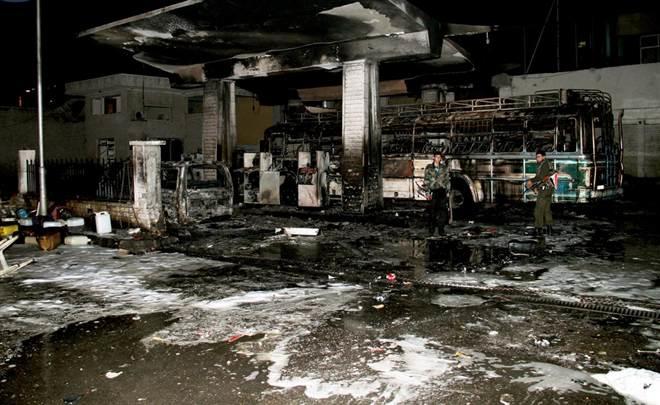
As an enforcer, the government should ensure that its laws and regulations are strictly followed by all the players. The government should commission agencies that will conduct regular assessments at various service stations to determine if the oil distribution companies are adhering to the set laws and regulations. This should include the qualification of the employees, their number, the disaster management system, and any other pertinent issues regarding safety at the service stations.
Terrorism is another cause of concern that many oil companies have been grappling with within the recent past. according to a report by Darke (2014, 98), a group of Boko Haram militants attacked a petrol station in the province of Kano in Nigeria killing ten people and wounding scores of others. This is a clear indication of the vulnerability of the petrol stations. Terrorists consider these service stations as low-risk high impact target points to commit their heinous crimes. These spots are low risk to them because they are not tightly guarded by armed officers. This means that they require less manpower and arms to launch a successful attack. They consider the stations to be of high impact because of the multiple explosions expected when they ignite the fuel. The reality of such attacks has also been seen in Lebanon and Syria (Stadtler & Kilger 2008, p. 79).
The threat of terrorist attack is unique and cannot be easily handled as other normal cases of accident. The attendants may not have ample time to respond to such attacks. In some of the cases, they are the ones who die first because they are the target of the terrorists. Some of such attacks are well calculated and they target the disaster management system, crippling any efforts towards fighting the resulting explosions. According to Rebonato (2011, p. 55), terrorist attack at gas stations is a threat that one company cannot face on its own. It needs the coordination of other companies, including the government to detect and deter such criminal acts before they can be committed.
An oil tanker that is full of fuel should also be considered a potential threat within a petrol station. They can form be an easy target for the terrorist. When they explode within a petrol station, the impact can be disastrous, as shown in the figure below.
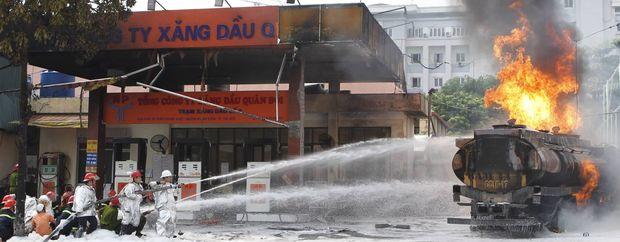
It is, therefore, recommended that all the oil tankers should be unloaded as soon as they arrive at the station. The tankers that are not yet loaded should be packed several meters away from the service station where they cannot pose any threat.
Case Study
According to Rebonato (2011, p. 73), sometimes it may be necessary to use case studies to demonstrate the possible impact of an accident that may occur in a petrol station if care is not taken. Case studies give real-life examples of an event that was either well-managed or poorly-managed, and the consequences that resulted from it. The following is a case that demonstrates the vulnerability of petrol stations.
Case 1: Explosion at a Gas Station in Syria Kills a Dozen People and Wounds Several Others
According to the report by NBC News, there was an explosion at a gas station at Barzeh, in Syria’s capital city of Damascus on Thursday, January 3, 2013 (Darke 2014, p. 87). The incident took place at around seven in the evening and the cause of the fire remains unclear. At the time of the accident, there were over two hundred people at the station who queued for fuel that was scarce in this region and the adjacent restaurant. The stations had been crowded for several days because it was one of the few stations that had gasoline. The explosion occurred minutes after a car packed close to the service station. This part of the city was in control of the rebels who were fighting the government of President Bashar Al-Assad.
The station, which was previously owned by Total, was not under the management of the rebels. The attendants at the station were ill-prepared for such an eventuality and four of them perished from the explosion. At the time of the explosion, the station did not have any equipment that would help in fighting the fire. The fire spread uncontrollably to the restaurant that was a few meters from the station, razing it to the ground. Over fifty other people sustained serious injuries while a score of others sustained minor injuries. The destruction of property was estimated to be more than 1500,000 dollars (Darke 2014, p. 88). This included the station that was destroyed, the tankers packed within the station, other vehicles, the restaurant, and consumables destroyed in the fire. The fire below shows part of the properties that were destroyed in the inferno.
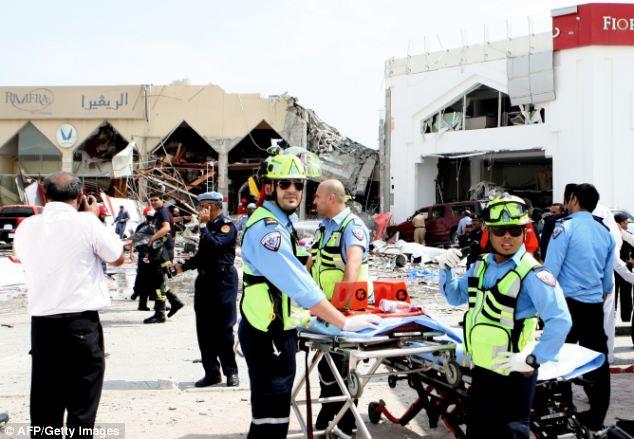
Mixed accounts have been given about the actual cause of the fire. While the government held that this was a normal accident that was bound to happen given the large crowds that always flock at the station and inadequate disaster preparedness at the station, the opposition is giving a different account. According to the leaders of the Revolution Leadership Council, this was an act of aggression by the government against the people perceived to be fighting against the government of President Bashar Al-Assad. The car believed to have caused the accident had been packed at the station for about ten minutes and it had no driver in it. This conspiracy theory has been accepted, especially among the victims and people in opposition who believed that this was a well-organized attack meant to cripple the opposition. The delicate nature of the petrol station was a good target for the terror-like attack.
Analysis of the Case Study
The explosion at a Syrian gasoline station is one of the best cases of the potential threat that lies in a petrol station. When analyzing this case, it will be important to look at three major areas of the cause, course, and impact. The cause of the accident remains unclear because of the mixed reports given by the people in authority. Taking the account given by the government officials about a possible accident, there is a clear indication that there are many possible causes of the fire that may lead to serious accidents in a gas station. The management of this station was not properly equipped with tools that could detect potential threats.
The employees either lacked the skills to detect these threats or were too complacent to issue directives on how clients should behave within the station. Taking the account of the opposition about this being an attack by government-sponsored terrorists, this case shows how vulnerable petrol stations can be when they become targets for the terrorists. It also shows how inadequately prepared the management of this station was in countering attacks that target its properties. Whichever account that one may take, one fact that comes out is that the attendants at this station were unable to handle any threat caused by accident or well-calculated terrorists’ attack.
Analysis of the course of the accident also portrays very big gaps in disaster management at the petrol station. According to an account given by one of the attendants who narrowly escaped death, all the fire fighting equipment was not operational because they had not been serviced for over two years. Some of them were trapped in fire because of their poor locations. The attendants did not know how to fight the fire because they had never been taken to any form of training. They were rebel fighters who had sustained injuries at war and could not be on the battlefield anymore. That is why they were transferred to be attendants at the station.
Situations where petrol attendants lack any emergency management skills are very common at many organizations, and this is clear proof that it is a recipe for a disaster. Some of them could not even rescue themselves, let alone participate in rescuing others who were at the station. According to an account of one of the eyewitnesses, it took about ten minutes for the fire to spread to the restaurant. This was ample time to deal with the fire if the station had proper equipment and qualified personnel at the station. The aftermath of this accident was massive destruction that would have been avoided if the station had proper equipment with well-trained employees.
Research Methodology
When conducting research, it is necessary to define an appropriate research design. This refers to the method to be used in the collection of data and the subsequent analysis. The research used both primary and secondary sources of data. Secondary sources of data were collected from relevant books, journal articles, newspapers, and reliable online sources. The primary data was collected from a team of participants who have experience in management. The researcher sampled a group of supervisors and mid-managers in three main firms that have petrol stations within the city. Given that the sample was taken from three different companies, the appropriate sampling technique was considered to be stratified sampling (Hakim 2000 P. 53). Each of the three categories was assigned the same weight when sampling.
This is qualitative research, which means that data analysis took a descriptive approach. Although the quantitative approach may also be appropriate in this study because of the need to conduct a mathematically-supported empirical study, the researcher considered the qualitative study more appropriate in this case. This research needs a detailed explanation of the factors that may cause potential threats within the petrol stations operated by ADNOC. Getting the numerical values alone may not help much. It is important to explain the potential threats, and how they can be managed to avoid their consequences within the petrol stations. Another important issue was the validity and reliability of the study. This research is expected to be used to redefine the management approach at petrol stations not only in this country but also in other regions around the world. The researcher was, therefore, very keen to ensure both internal and external validity of the study are maintained.
Qualitative research is one of the most commonly used research methods in social sciences. Punch (2005, p. 89) defines qualitative research as “Ethnographic, naturalistic, anthropological, field, or participant observer research.” As this definition suggests, qualitative research methods involve the investigation of specific issues through field studies, case studies, ethnographic, anthropological, or naturalistic studies. When conducting research, it is important to determine when it is appropriate to use qualitative methods. This will require one to find out the differences that exist between qualitative and quantitative research methods, and the context under which each of them is appropriate.
Qualitative research was traditionally used in social sciences because of its descriptive nature. The desire to get the answers on why or how a phenomenon occurred made the social scientists rely heavily on qualitative other than quantitative research. As Yin (2003, p. 132) puts it when answering the why and how questions, numerical data may not offer an appropriate solution. This makes it necessary to have data that can describe why a phenomenon happened, and how it happened. It is for this reason that the researcher considered it necessary to use qualitative research in this study. The researcher will conduct a critical review of the literature to determine risk factors at petrol stations, and how these factors can be regulated to avoid their negative consequences.
The Relevance of the Research Method
According to Punch (2005, p. 50), when choosing an appropriate design, it is necessary to give a detailed justification as to why a given research method is more appropriate than the other ones. In this section, the researcher will look at the theoretical perspective of this research design and the philosophical paradigm that makes it necessary to be used in this specific study.
Philosophical Paradigm
Qualitative studies are very unique based on the philosophical tradition it uses in its ontological and epistemological assumptions. Looking at the philosophical paradigm of qualitative research may help in understanding how it will be relevant in this study. It makes it necessary to look at some of the relevant theories and research concepts commonly used to support the use of qualitative research.
Grounded theory
Grounded theory is one of the most commonly used theories in qualitative research. In defining Grounded Theory, Yin (2003, p. 67) says that it is “A general theory of scientific method concerned with the generation, elaboration, and validation of social science theory. The scholar further notes that grounded theory aims to develop theories that will help in understanding a phenomenon. When using this theory, it is necessary to derive data inductively. This form of research differs from other traditional forms of research. As Punch (2005, p. 117) observes, in most of the traditional studies, a researcher would select an appropriate theory and collect data to support it based on a given phenomenon. This is the complete opposite of what happens when using grounded theory. In this theory, a researcher will collect data from the field, analyze it, and develop an appropriate theory base on the collected data.
According to Maxwell (1996, p. 92), this concept of grounded theory combines two contrasting traditions of sociological studies which are symbolic interactionism and positivism. When data is collected from the field, its analysis, based on this theory, follows three basic steps. The first step involves coding the text and then theorizing it. The second step involves memorizing the data and then theorizing it. The third step involves integration, refinement, and writing up of the theory. At this stage, the researcher shall have come up with a strong theory that is backed by the collected data about a phenomenon under study. It is important to note that Grounded Theory has met criticism from some scholars who believe that its approach is a signal to the return of Baconian inductivism. However, Winter (1995, p. 82) dispels such criticisms claiming that this theory is strongly grounded on scientific research methods.
Phenomenology
Phenomenological studies are part of qualitative research that will be very relevant in this study. According to Kemmis (1991, p. 48), phenomenology focuses on the experiences that one gathers during a given event. A participant in a phenomenological study must have had a first-hand experience on a given event in a way that he or she can give an account of what took place. A researcher may be interested in understanding why or how a given event took place. It may be possible to use the current data to deduce what could have happened during such an event that resulted in what we currently have. However, sometimes the deductive approach may require some assumptions or even guesswork because the researcher or people involved in the study did not have the experience in what took place.
The deductive approach will always base its reasoning on events that happened rationally and in an expected manner without any abnormal twists. However, it is a fact that sometimes events are caused by twists, some of which are supernormal. This means that the outcome resulting from such a deducting approach may be wrong. That is why phenomenology focuses on the logical path that involves the experience. One must have had the experience of an event to give a clear picture of what took place. In this study, the researcher will be looking at the risk factors based on the accounts of those who have witnessed some of the consequences.
To do this, a researcher may need to engage two groups of participants. The first group of participants must have worked in petrol stations that experienced accidents or incidents that were properly managed because of the presence of adequate equipment and highly qualified employees. The second group will be participants who experienced an accident or incident at the petrol station that was poorly managed because of poor equipment and ill-trained workforce. These participants can give accounts of what happened that led to massive destruction or events that led to timely arrest of what would have been a major disaster.
Ethnography
According to Yin (2003, p. 58), ethnography is another popular design when using the qualitative research method. Sometimes the respondents may hide or twist given information when interviewing them for various reasons. A respondent may hide information to protect themself, to avoid intimidation, or to protect an organization that is of value to him or her. Sometimes the responses given by the participants may be exaggerated or diluted for the same reasons. That makes it necessary to use ethnographic studies. When using ethnography, a researcher will be forced to be part of the system. Instead of getting the information from a third party, the researcher will go to the field and get the experience directly.
For instance, this research focused on looking at the risk factors at petrol stations and how they can be handled. To have the right data, the researcher may need to be part of a given organization for some time. Through personal experience and direct interaction with all the relevant environmental forces, the researcher will be able to determine all the risk factors and how they can be handled to eliminate their negative consequences.
When taking this approach, a researcher may need to work within the station as an employee to determine how these forces may occur. If the cases occur, it will be necessary to record these events, specifying the causes, course, and consequences. The data collected from such processes are always precise. However, Kemmis (1991, p. 38) says that this concept requires a lot of patience. It may not be appropriate for a study that is expected to last for a short period. This is so because the researcher will have to spend a lot of time trying to be part of the system to collect the relevant information. Sometimes this can last as long as one or two years. Another weakness is that it is subject to the perceptions and biases of the researcher. What the researcher considers normal can easily be ignored. However, the ignored factor could be the major that may cause a potential threat at the stations. This one-sided view may not be appropriate for the research’s validity and reliability.
Case studies
Sometimes case studies may be relevant when conducting qualitative research. Punch (2005, p. 72) defines case studies as “In-depth analysis of people, events, and relationships, bounded by some unifying factors.” A case study is always more appropriate when looking at a more specific issue within an organization. It is also appropriate when making a comparison of issues in two or more organizations. When looking at safety assessment at ADNOC Distribution service stations, using a case study may be necessary. When doing this, a researcher will look at actual events where a safety concern occurred at any of its stations, and how the relevant officers dealt with it. Through such case studies, the researcher can look at the real event from an unbiased point of view. This way, the researcher can identify areas of strength and weaknesses and how this affected the ability of the firm to manage safety issues at the station.
Case studies can be perfect when conducting comparisons. In this regard, a researcher would need two organizations that are known to have different management strategies in this oil industry. This way, it will be easy to determine how the management approaches used at a given organization affects the ability to manage safety issues at the petrol stations. The researcher can go further to analyze other factors that may make one company better in managing these threats than others. McNiff (1992, p. 87) warns that when using case studies, care should be taken to avoid misinterpretations. The fact there are lower cases of safety concern may not necessarily mean that it is as a result of a given management strategy. Other forces may affect the safety concerns at the petrol stations. Such other factors may include reduced risk factors, the enlightenment of the clients who visit the stations, or even an issue of mere luck. For this reason, a researcher should go as far as interviewing the participants about leadership.
Benefits of Qualitative Research
It will be necessary to look at the benefits of using qualitative research that made it appropriate for this study. This type of research is very beneficial to the participants of the study. According to Easterby-Smith, Thorpe, and Lowe (2001, p. 59), qualitative research offers participants a rare opportunity to give a detailed account of an issue in their own words. If it is an issue that is affecting them such as potential risks at the service stations, then they will be able to explain it on their terms. This way, the issue can be corrected in a way that will meet their desires. To the users, qualitative research is the most appropriate when it comes to giving details on an issue. When users are only provided with statistics, it may not be very beneficial to them if it is not accompanied by a proper justification. Qualitative research offers a detailed description of a phenomenon that will give the user a clear view of the issue under investigation.
Ethical concerns
When conducting research, it is important to take into consideration the issue of public and professional ethics. Issues that may raise controversy or public concerns should be avoided. Professionally, a researcher must protect the respondents. The identity of the respondents should not be revealed to anyone because they may be intimidated in case their views conflict with that of the rest of the population. It is also professionally unethical to reproduce the work of another researcher and claim ownership of it (Easterby-Smith, Thorpe & Lowe 2001, p. 33). That is always considered plagiarism, one of the worst offenses in research. When one ignores these public and professional ethical concerns, the resulting report may fail to be of any value because it will not be adding anything to the existing body of knowledge. One can even be sued for violating copyrights of other scholars, leading to fines or even jail term.
Analysis and Interpretation of Findings
It is clear from the data collected that distribution service stations are very sensitive places that should have an effective mechanism for managing potential threats. It will be necessary to analyze the findings to come up with recommendations on how to manage these stations in a way that will protect lives and property.
Bhatia (2008, p. 80) looked at the causes of natural gas accidents at the gas stations in two contexts. In the first context, he looked at the cases that were classified as major accidents and referred to them as notifiable cases. The graph below shows some of the common causes of such incidents from 1993 to 2011.
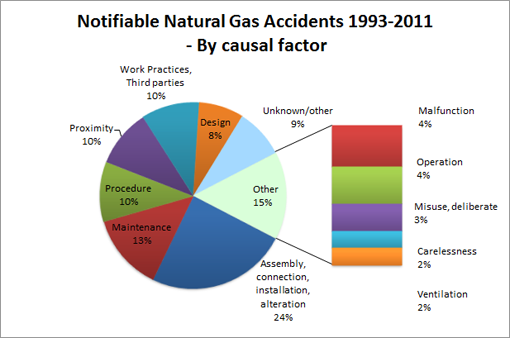
As shown in the statistics above, assembly, connections, installation, and alterations are some of the leading causes of accidents at the gas stations. Poor maintenance has also been identified as a major cause of the accidents and so is the procedure followed when handling customers or unloading fuel from the tankers. Work practice and third parties such as the customers also pose a major threat. Malfunction, operations, misuse, carelessness, and ventilations have been identified as minor issues.
According to Bhatia (2008, p. 79), none of the issues identified above, either major or minor, should be disregarded. All of them should be treated as potential threats that must be addressed to eliminate the potential threats within the distribution service stations. The factors identified by this scholar are the exact factors talked about during the literature review. The researcher also looked at the gas station accidents that were considered minor and referred to them as non-notifiable. The figure below shows the trend in such accidents from 1993 to 2012.
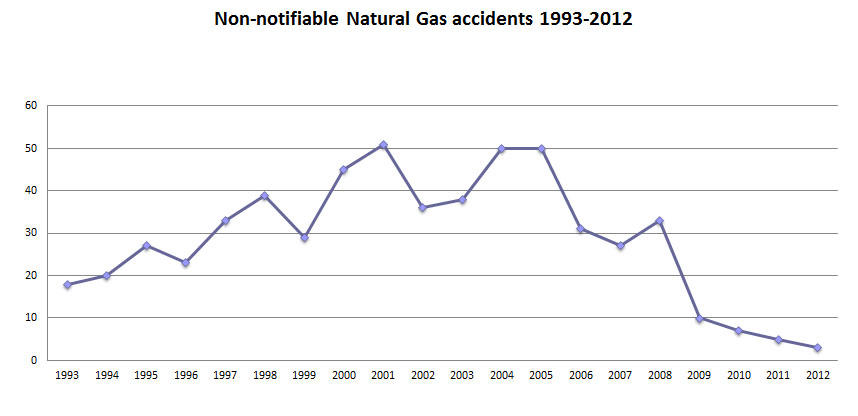
As shown below, the effort of the stakeholders in this industry has borne positive fruits. From 1993 to 2005, there was a consistent increase in such accidents. However, the trend changed from 2006 when the statistics started falling consistently. In 2012, these cases were at their lowest in the entire Middle East region. The scholar says that this positive trend has been witnessed globally following the best practice that many firms are now employing based on research from some of the leading oil companies such as Shell and BP. Bhatia (2008, p. 87) looked at the statistics of people who often perish in distribution service stations in the United Arab Emirates. He looked at their gender and age groups. The graph below shows the statistics.
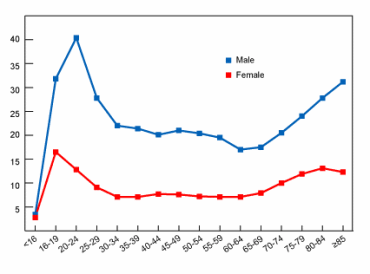
As shown in the graph, more males than females do perish in such accidents. This is so because men make the majority of the drivers in this region. In terms of age groups, young adults between the ages of 19-25 are at the greatest risk. The researcher blamed this on the fact that at this age, people tend to make many mistakes either because of the desire to appear a superhero or the fact that they are handling cars for the first time in their lives.
The middle-aged people are at the lowest risk of getting involved in such accidents. Their experience and strength make it easy for them to escape when danger strikes. However, the aging population, especially those over 75 years are again at a higher risk of getting involved in accidents. This may be attributed to their reduced strength and inability to escape when they are caught up in such accidents.
Benchmarking and Best Practices from Shell
According to Darke (2014, p. 88), one of the ways of improving a firm’s system is to benchmark best practices in the industry. Emulating the best may help a firm in its efforts towards becoming the best. According to Jacoby (2012, p. 70), Shell is one of the major oil distributors that have come up with the best strategies on how to enhance security at their service stations. They have come up with ultra-modern designs for their service stations that offer a wider space to fight fire outbreaks at the stations. The figure below shows this new design.
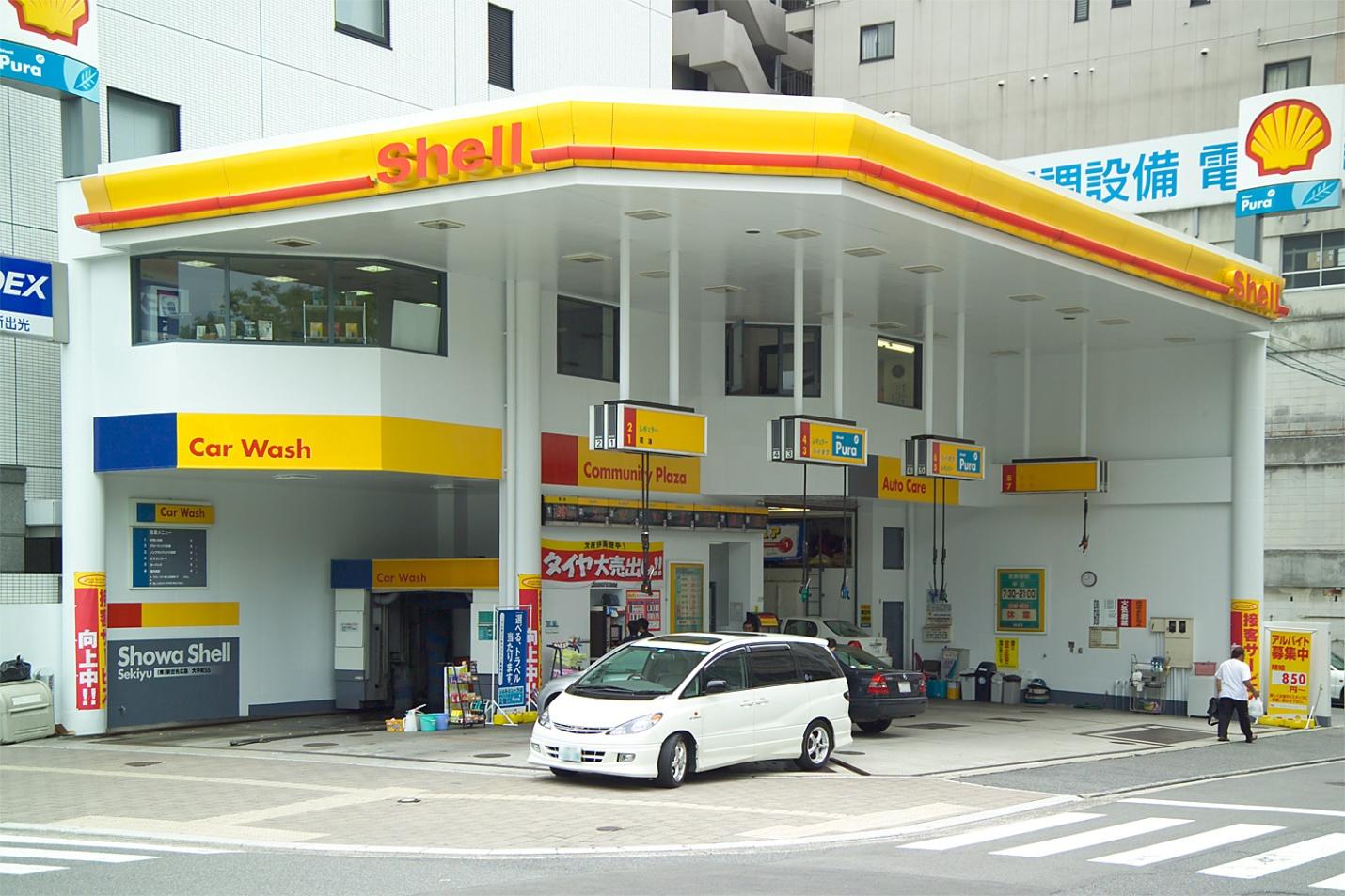
The petrol tanks are deep in the grounds, with automatic valves that shut the system in case of fire, making it difficult to have an explosion at the station. As shown in the picture, the fire fighting equipment and alarms are strategically located within the station to make it easy to respond easily to any threat. This is very different from the design used by ADNOC shown in the figure below.
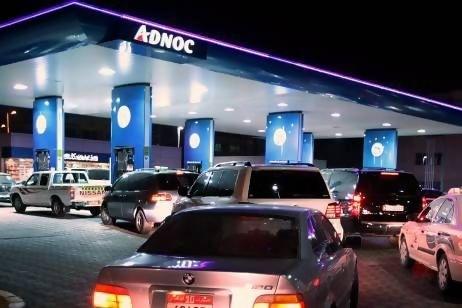
Such crowded stations as the one for ADNOC shown in the above figure can be very dangerous in case of outbreaks because the response team may not find it easy accessing locations that are in flames.
Conclusions and Recommendations
ADNOC is making impressive progress in its effort to expand its operations to the global market. However, safety concerns at its distribution service station are an issue that may affect the progress. The threats have been identified as poor assembly, connection, installation, maintenance procedures; poor work practices; malfunction, operations failures, misuse of equipment, and carelessness among the attendants.
Another major threat that is taking a new form is terrorism targeting the service stations. To address these concerns, there is a need for different stakeholders to work as a team to find a lasting solution. Some issues may be addressed internally, but others such as terrorism may need support from the government and other stakeholders. ADNOC should consider the following recommendations as it tries to address the threats at its service stations in the global market.
- The management should hire highly qualified employees to work in its service stations
- The employees should have regular training on how to handle various threats, including the new threat of terrorism
- The management should ensure that all the equipment at the service stations is regularly serviced or replaced to avoid cases of malfunction.
- ADNOC should follow the best practice set by firms such as Shell when it comes to designing the petrol stations.
- The management of this firm should get involved in public awareness campaigns to ensure that the public understands safety measures when they visit service stations.
- This firm should work together with other stakeholders such as relevant government agencies in fighting threats such as terrorism.
Evaluation
I believe Abu Dhabi National Oil Company has great potential in the oil industry. The firm has control at all the stages in the supply chain, from extraction, processing, transportation, and distribution, and this gives it a competitive advantage over other market rivals. However, I believe that this alone may not help this firm to achieve the desired success in the market. The firm may find its rivals that have only specialized in distribution performing better because they do not have to spread their resources.
The management of ADNOC should start addressing the issue of safety at the distribution service stations by reviewing the credentials of its station attendants. Only those with the right qualifications should be retained. The employees should then be subjected to regular training to make them capable to handle various risks. Currently, I believe the system used at this firm is inadequate and cannot respond to some of the current sophisticated threats such as terrorism targeted at the petrol stations. The management should, therefore, act as soon as possible to address this problem.
References
Bahgat, G 2013, Alternative energy in the Middle East, Palgrave Macmillan, Basingstoke.
Bhatia, S 2008, Retail management, Atlantic Publishers & Distributors, New Delhi.
Cohn, M 2010, Energy law in Israel, Kluwer Law International, Alphen aan den Rijn.
Darke, D 2014, My house in Damascus: An inside view of the Syrian Revolution, Cengage, New York.
Easterby-Smith, M, Thorpe, R, & Lowe, A 2001, Management research: an introduction, Sage, London.
Hadland, A 2002, In terror and in silence: An investigation into safety levels and standards at petrol stations: Petrol Station 5 Safety Project, HSRC Publishers, Cape Town.
Hults, D, Thurber, C & Vimor, G 2011, Oil and Governance, Cambridge University Press, Cambridge.
Jacoby, D 2012, Optimal supply chain management in oil, gas, and power generation, PennWell Corp, Tulsa.
Kapoor, R 2011, Services marketing: Concepts & practices, Tata McGraw Hill Education, New Delhi.
Kemmis, S 1991, Action Research for Change and Development, Gower, London.
Kratschmer, P 2011, Organisational culture is highly resistant to change, GRIN Verlag GmbH, Munich.
Maxwell, A 1996, Qualitative research design: An interactive approach. Applied Social Research Methods Series, vol. 41. no. 5, pp. 34-98.
McNiff, J 1992, Action research: Principles and Practice, Routledge, London.
Mohamed, N 2013, Technological Change and Skill Development in Arab Gulf Countries, Springer, Cham.
Motavalli, J 2001, Forward Drive: The Race to Build the Clean Car of the Future, Earthscan, London.
Plunkett, J 2008, Plunkett’s energy industry almanac 2009: The only comprehensive guide to the energy & utilities industry, Plunkett Research, Houston.
Punch, K 2005, Introduction to Social Research: Quantitative and Qualitative Approaches, Sage, London.
Rebonato, R 2011, Plight of the fortune tellers: Why we need to manage financial risk differently, Princeton University Press, Princeton.
Shah, J 2009, Supply chain management: Text and cases, Pearson Education, Upper Saddle River.
Stadtler, H & Kilger, C 2008, Supply chain management and advanced planning: Concepts, models, software, and case studies, Springer, Berlin.
Waters, C 2011, Supply chain risk management: Vulnerability and resilience in logistics, Kogan Page, London.
Winter, R 1995, Learning from Experience. Principles and Practice in Action Research, Falmer Press, London.
Yin, R 2003, Case Study Research – Design and Method, Sage, London.